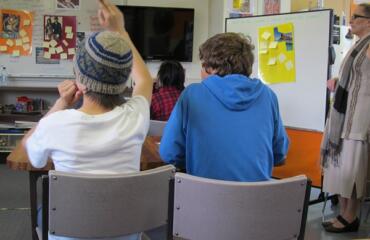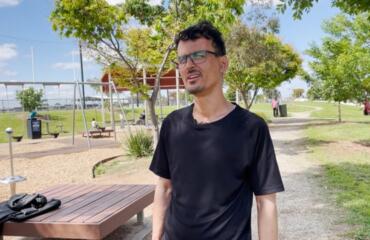She only has 15 students, but Steph Whitelum may well have the world’s biggest classroom.
It stretches over an expanse of central Australian red sand, rock and scrub twice the size of France. Social distancing etiquette poses no issue for her students, whose nearest classmates may live a long day’s drive away.
Each morning begins in one of the four studios at Alice Springs School of the Air where Whitelum, headset on, signs into her online classroom to take her students, aged between six and eight, through the first activity of the day.
This is what contemporary distance education looks like. With schools across the country scrambling to move their teaching online, and desperate parents wondering how best to support their kids learning at home, there are invaluable lessons in the expertise Whitelum and her colleagues at the School of the Air have accumulated, building on 70 years of remote teaching with technologies from radio to broadband.
Lesson one is that many of the standard strategies of the conventional classroom don’t work remotely. Teaching early primary students remotely poses particular challenges, Whitelum says, because so much of their learning occurs through activities and playing together. So she tries to create those opportunities for her far-flung students wherever she can.
“I try and include lots of moving and singing and dancing,” she says. “I even ask them to bring things to manipulate because I can’t expect them to sit there for half an hour and be engaged in the screen like you or I can.”

A key part of Australia’s School of the Air distance education model is the use of trained home tutors. “They are there for each lesson, so they see all the content I deliver,” says remote teacher Steph Whitelum. As students around Australia transition to home-based learning, parents are going to require enormous support, experts say.
And so the students may be sitting at their desks with their favourite toy, following Whitelum as she pretends to clamber up an animated mountain backdrop.
“I have a Chromecast function, so I can make it look like I’m swimming underwater or walking through a jungle, so I can make it look good, but you can’t do that for the whole lesson.”
Young children have an incredible capacity to absorb information. The trick, says Whitelum, is holding their attention. So she keeps lessons short, just half an hour at a time, and schedules plenty of action to keep the kids involved.
“You have to get pretty creative and use a variety of things to keep them engaged. So that’s a battle.”
Variety is also the name of the game at Santa Sabina College in Sydney’s inner west, where teachers have – like so many around the country as the coronavirus crisis has intensified – been planning furiously for the transition to online learning over the past couple of weeks.
“We already used many of the tools for online learning, now we’ve just got to ramp up how we use them,” says Santa Sabina’s head of learning technologies Zeina Chalich. “We are taking a blended learning approach, with a mix of online and offline resources shared with students on a weekly planner.”
Each Santa Sabina primary school student has been given a bag full of resources like books, activities and games to complement their online lessons when teaching moves online.
“There’s a lot of talk about being agile and adaptable, but this is really going to test us,” says Santa Sabina’s principal Paulina Skerman. “Teachers are stepping into a whole new way of planning and teaching in a matter of weeks, so it’s a major challenge, clearly.”
Chalich says one of the main challenges of teaching remotely will be trying to maintain some structure to the school day without overdoing the screen time.

Teachers at Santa Sabina College learning to use the interactive Padlet app earlier this week.
“We might login and start the day with the whole class, and then let them go off and do activities, with teachers online at all times and checking in regularly, a bit like we would face-to-face.”
But even the most perfectly planned and executed online lessons would be pointless without adult support on the other side of the screen. This is where the School of the Air model reveals the aspects of distance education that may be more difficult to replicate in households if and when schools move online.
A core part of the School of the Air model is ensuring that every student has a “home tutor”. This is often a parent, but in the context of remote farms and communities, it might be someone employed in the household – for instance a school leaver on an outback gap year. These tutors are themselves given training and support to help the remote delivery of curriculum and are a fully engaged part of the virtual classroom, not helicoptering in and out between other tasks or responsibilities.
Steph Whitelum says it is hard to see how remote learning programs might work effectively without this level of tutor support.
“The home tutors play a huge role,” she says. “They are there for each lesson, so they see all the content I deliver.”
They provide more than just structure. During each lesson, Whitelum will model activities for the home tutor to deliver after the class has finished.
“So the kids have the home tutor to work with both during and after our class lessons,” she says. “They’re like a second teacher, really.”

A Santa Sabina College student practicing online learning.
Zeina Chalich says she is trying to give parents as much support as possible as the school prepares to go online.
“We know that with the younger years it is particularly important parents have supervision and control,” says Chalich, “so we are providing very clear instructions for them to support home learning.”
Nonetheless, stepping into the breach as a home tutor is a role that many working parents may find impossible to fulfil.
“Parents are going to find themselves in a potentially difficult scenario trying to balance work and home schooling,” says University of Melbourne educational psychology expert Chelsea Hyde.
Just in the past week, there has been a cascade of articles and social media posts from parents expressing a range of reactions to their new dual roles, among them this viral rant by one Israeli mother that has had over 180 million views.
Hyde, who published an article on Tuesday with five tips to keep kids learning at home (see panel below), says that even parents who do find a balance may still take a week or two to get their heads around the technology.
“Many of the children will actually have a better grasp of the technology than their parents,” she says.

But there are also many who simply don’t have access to the necessary technology or networks. The 2019 update of the Australian Digital Inclusion Index, which tracks and scores digital access, affordability and ability at a household level, reveals that there is still a substantial and – in some areas – growing digital divide between richer and poorer Australians.
People in low-income households have a digital inclusion score of 43.3, which is 30.5 points lower than those in high-income households (73.8). And while the capital city-versus-country divide has improved, there are still substantial black holes in rural areas, and Indigenous digital inclusion remains low.
With public pressure growing to shut down schools, New South Wales Public Education Foundation executive director David Hetherington told the ABC this week that he was deeply concerned that children in struggling households would be left behind as schools shifted into online learning, describing Australia’s digital divide as “a chasm … it’s bigger than most people think”.
“The online model is definitely skewed towards those with more resources,” says Hyde. “In other countries they’ve had to provide alternatives like printed materials to support kids’ education, so schools will have to get creative.”
“It’s a complex situation,” says Victorian Principals Association president Anne-Maree Kliman, acknowledging that some schools simply won’t be able to teach online.
“It will vary from school to school,” says Kliman, “some schools, even in low socio-economic areas, have fantastic access to devices.” But she says that many families don’t have the resources necessary for online learning.
“Say you have a family with internet, but only one computer and everyone is in lockdown. Who is going to use the family computer if everyone is at home?”
Chelsea Hyde also works as a school psychologist, and as she watches this crisis play out her main concern is the effect of social isolation on young children who don’t fully understand what is going on. She has been urging families to think creatively about how to overcome these by using whatever tools they can to stay connected.
“If we are getting to a stage of extreme social distancing that could become really tough for young kids who are used to seeing their friends and even their grandparents regularly,” she said.
“There really needs to be virtual ways for these kids to keep speaking to each other.”




